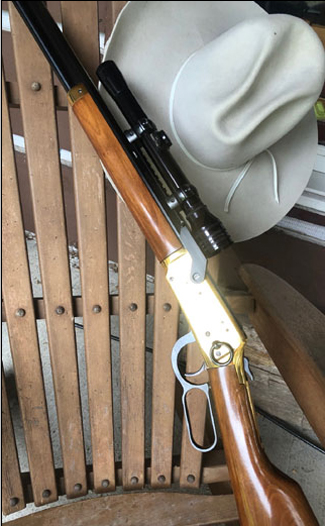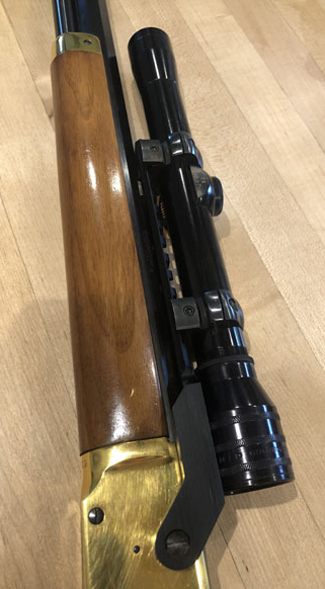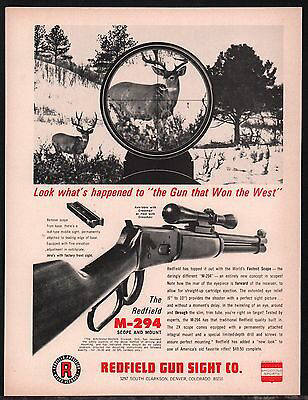“The Man with the Golden Gun” sounds like a great title for a James Bond movie, actually it is, starring Roger Moore as 007. I wonder if the idea for this 1974 Ian Fleming classic came from another creative mind, Oliver Fisher Winchester. Eight years earlier Winchester had come out with the original golden gun, a 24K gold plated model 1894 commemorating Winchester's 100th Anniversary. The 1966 Centennial model replicates its ancestor, the famous 1866 “Yellow Boy”, the first Winchester model ever made.  Originally produced as a collector’s edition, the Centennial ’66 was also one of the most accurate Winchesters ever designed, supporting a 26” octagon barrel, weighing 8 lbs and chambered in the famous 30-30 caliber. This excellent shooter had a limited run of just over 100,000 and was only manufactured in 1966.
The ’66 also came in a carbine version with a 20” barrel but it is the long rifle that truly stands out and is not just another pretty face in the crowd.
Originally produced as a collector’s edition, the Centennial ’66 was also one of the most accurate Winchesters ever designed, supporting a 26” octagon barrel, weighing 8 lbs and chambered in the famous 30-30 caliber. This excellent shooter had a limited run of just over 100,000 and was only manufactured in 1966.
The ’66 also came in a carbine version with a 20” barrel but it is the long rifle that truly stands out and is not just another pretty face in the crowd.
I spent several weeks searching the internet for just the right gun, one that was affordable. Somewhere along the way, once the original packing had been lost or discarded, the guns become more affordable and less attractive to deep pocketed collectors.
My ideal gun needed to be 'new old stock', meaning not fired or hunted with but not necessarily NIB. Current prices range from $400 to over $700 with the average falling into the mid 400 range. I was lucky enough to snag mine for $100 below average and I’m quite proud of myself for doing so. The original manufacture's price in 1966 was just $125.00.
So what sent me on this quest to find this ‘Holy Grail’ of rifles?
Well it started back in the early seventies when I was just a teenager. I came a across a book called the ‘Hunter’s Bible’. In it was a photo of two men, a canoe and a startled buck. In the hands of one of the men was a lever action rifle, at the ready, to take a quick snap shot at the fleeing 10 pointer. The rifle was a Savage 99! So I ordered it, through the mail, while still in high school, delivered to my home within a week. One could do things like that back then, when society was a little more tolerant.
I ordered the Savage in a .308 Win and also ordered a Weaver K4 scope to complete it. At the time that was my big game gun. I had it for almost 45 years before I decided I wanted a flatter shooting and more accurate Weatherby .308 bolt action rifle with a faster 1:10 twist. I also wanted a lever action in the 30-30 Win rather than the .308 '99, to compliment my hunting rifle quiver. I ordered my Weatherby through my local FFL, sold my ‘99 to the same and also ordered and bought a used 30-30 Marlin 336 stamped JM. That one came with the very popular Redfield 2x-7x scope.
The Marlin had a cross bolt safety which I disdained and ordered a saddle ring adapter from Beartooth Mercantile to swap out the safety and make the gun look nicer. Somehow that Marlin still didn’t sit that well with me so I sold it after one season. Then came my quest!
My good friend from Colorado, Morten Fadum, invited me out to go Antelope hunting in the fall. Pronghorn, as they are also called, require a flat shooting rifle and cartridge and fortunately for me I had such a gun, my .308 Weatherby! Combined with a Barnes TTSX 150 grain cartridge this setup was ideal according to Mort, exactly what the doctor ordered.
Not so fast! Shooting antelope was a true western tradition and right away good ole’ Teddy came to mind. What would he use, I asked myself. What would any cowboy use, definitely not a modern day flat shooting bolt action rifle with high powered optics. Nope that won’t do! Much to the chagrin of my dear friend!
No, Teddy and a slew of other true cowpokes would use their trusty old Winchesters, maybe not in a 30-30, but a 1894 none the less. So my mind was made up! I needed a Winchester model ’94 in a 30-30 (plus I had several boxes of ammo leftover from my Marlin venture). Additional criteria for my gun called for a flat shooter, a long range ’94, with a 26” barrel.
Being of Canadian descent, my first attraction was for the Commemorative Canadian Centennial ’67. I scoured the online auctions for one and found several in the right price range. Unfortunately while doing so and using the key words ‘Winchester Centennial' in my searches, I came across the beautiful ’66 with its golden receiver! Well it was love at first sight!
The added attraction of the ’66 was that it was plain, no fifty cent scrolling job to make it look a little too cheap for me. It had the long barrel, octagon to boot, curved butt plate and unlike the ‘67 rifle, it came with a saddle ring.
Ok, I think I had almost found my Holy Grail!
The first thing I needed to do was find out more about my new sweetheart, to see if it was really worthy of my love and not just attractive window dressing. After some googling I came across a great review by a well known gun expert Chuck Hawks, who thought the ’66 with its 26” heavy octagon barrel was the cat’s meow, accurate yet beautiful.
From reading his detailed article I gained another bit of interesting information which sent me on yet another unexpected quest, to find the proper sights for the ’66 to make the gun proficient at long range.
My original thought was to buy the traditional Sharp’s type tang and front sight combo made famous by Matthew Quigley. I researched and priced out a nice Vernier tang sight but along with a new globe front sight I was looking at spending close to $400. Nah, that’s a no! The sights cost more than the gun; I’d rather get the ’66 carbine version to add to my collection for that kind of money.
In the review article the author mentioned that he installed an EER type scope on his ’66 to maximize its long range capabilities. EER stands for extended eye relief most commonly found in handgun scopes were the shooter has to hold the gun at arm’s length. The Winchester because of its top ejection port doesn’t allow for a conventional scope or scope mount.
On the older Winchesters prior to the AE models (angled eject) to mount a scope it had to be ahead of the receiver as not to interfere with spent cartridge ejection. The options at the time were an offset scope base mount attached to existing screw holes on the receiver or to drill and tap something onto the barrel. The writer had a gunsmith tap his ’66 barrel since he didn’t like the offset mount and neither do I.
Ok, now I have a problem, actually two problems. I had to find an EER scope suitable for the ’66 and a mount to attach it with. Don’t forget, the ’66 has an octagon barrel to compound the problem. Once again I searched the internet for the answers and came across several!

The mounting base was simple. I found Dr. Pearson’s tactical rail mounts specifically made for the Winchester ’94. Although created for the carbine version and a non octagon barrel I ordered one anyway, since they were affordable enough to experiment with. With a little tweaking and smith work of my own I was able to fit the rail perfectly to my ’66 rifle. The rail accommodates the Weaver 1” medium scope rings needed for most EER scopes.
Now for the scope itself, I initially looked for an actual EER type scope recommended by Mr. Hawks in his review but found them also to be pricey, especially for a used one. His original choice was the Leupold M8 2x20 mm EER which had a 21’ field of view at 100 yards. I considered this until in my research I found a period correct scope made by Redfield. In 1966 Redfield manufactured a couple of scopes specifically engineered for the Winchester ’94; their FrontIER 2x scopes both in a 1” and 3/4" tube version.

The IER in Frontier stands for Intermediate Eye Relief, unlike the EER the IER is perfect for the ’94 with just the right amount of eye relief; 6-10”. The Leupold which is a true hand gun scope has longer than necessary eye relief causing it to be mounted further away from the shooter.
The 1” 2x Redfield Frontier that I chose is 11.25 inches in overall length and weighs in at 8 oz. and has a 30’ field of view at 100 yds, characteristics that add to the appearance and accuracy of the ’66. The extra three inches in length over the Leupold M8 makes the rifle look less modern and tactical, the extra 2 oz doesn’t hurt for stability when holding on target and an additional 10’ of field of view makes finding your target that much quicker.
Ok, I got the rifle, the scope mounts and the proper era of scope, now comes the mystical part, magically transforming my 24K '66 into a functional antelope rifle. I would need the help of an alchemist, metallurgist and pyrotechnician by the name of Hornady.
Some years back Hornady came out with a spitzer type bullet for the 30-30. No longer did one have to use a traditional flat nose or soft lead point Core Lokt type bullet with lower sectional density and velocity.
Hornaday’s Flex Tip LEVERevoltuion 160 grain ammo effectively increases the 30-30’s range from 200 plus yards to over 300. Whereas a .308 shots flat to 400 yards with a bullet drop of only -11”, the 30-30 duplicates this at 300 yards with a bullet drop of approximately -12”, that according to Hornady, when both calibers are sighted in at 3” high at 100 yds.
Now that’s with a 24” barrel, so the 26” barrel of the ’66 might be even better!.
The challenge in hunting antelope with a 30-30 isn’t in how well you can shoot at long distances; there is still the factor of getting close enough to shoot within a range that is ideal for your rifle and ammo. Everything need not be about distance but rather should be about one’s own ethical understanding of fair game and fair chase.
Oh! By the way, '24K Magic' is also the title of a hit song sung by Bruno Mars - "Twenty four karat magic in the air...Pop pop, it's show time"!